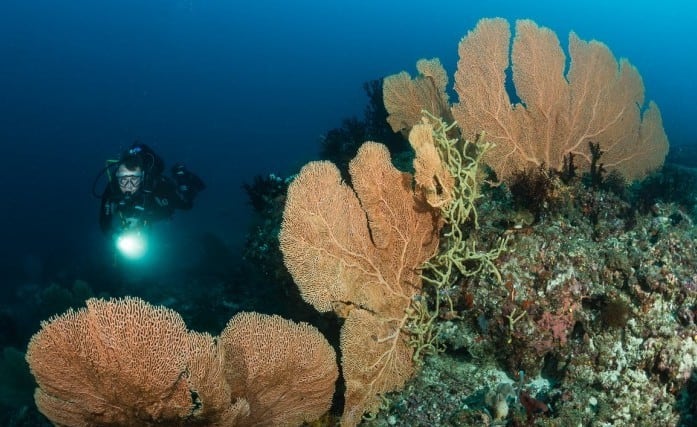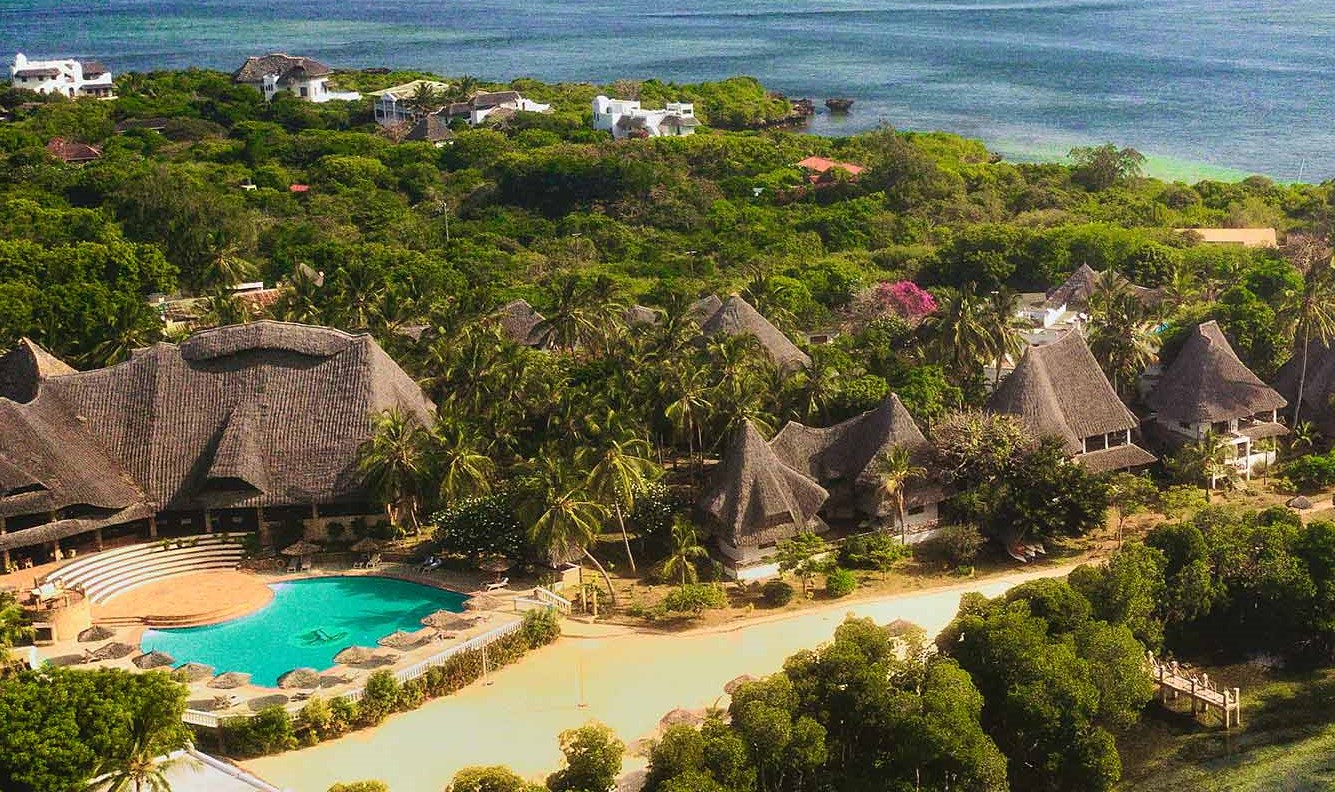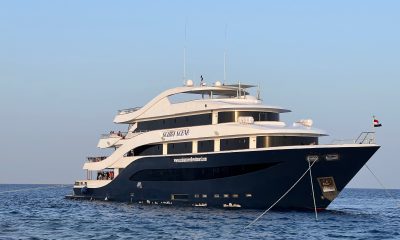News
Shooting in Less than Perfect Visibility in the Maldives

I’ve recently returned from the Maldives on the rather swish and fabulous MV Orion, one of the stars of the Constellation Fleet. Your approach to taking pictures in the Maldives has to be altered as the seasons and locations alter.
At times of the year the visibility can rival the Red Sea; however, a lot of the time it is compromised by comparison. One of the reasons that the waters in this area are frequented by large pelagic beasts like Manta and Whalesharks is because of the tiny plankton providing the major food for these ocean giants. This tiny plankton, in the main, is what hampers the visibility. If you’ve kept track of my recent Facebook posts of those Manta and Whalesharks though, you could be forgiven for thinking that the visibility was crystal clear. And certain adaptations are what is needed to shoot in this less than perfect visibility to make your photos look like the viz is clearer than it is.
I find that the age old adage of underwater photographers to “get close” is never more apt than when in these slightly murkier conditions.

This is exactly the sort of example that shows the Maldives looking its most colourful. It’s a deception really due to the colourful balled up anemone in the foreground, it’s been shot using a fisheye lens, and I’m shooting through only inches of water – the less than perfect viz is disguised.
A Fish Eye View
So I choose to shoot with a fisheye lens and really get close when shooting reef scenes, placing the main object of interest in the forefront of the frame. This tends to lead the eye into the picture which is a great compositional stand by, and it also has the benefit of shooting through much less water for this close object, so even if the background isn’t crystal clear and distinct, the foreground will be.
One of the more frustrating creatures to shoot well in the Maldives is the relatively frequent visiting reef sharks. Usually White Tips swirling in the currents at the edges of channels, but occasionally you may get visited by Grey Reefs too.
I have always had difficulty shooting these with my standard weapon of choice, the fisheye lens.

OK, here is a subject that demands a dramatic angle. I was shooting with a longer than normal focal length, so unable to let the drama by ramping it up with a “fisheye in it’s face” sort of a composition, which just wasn’t possible. Fearsome though they may seem, this shark like most was quite shy. So I opted for a short telephoto lens to make them big in the frame. This meant that to turbo charge the dynamics a bit I simply tilted the camera. Well actually I didn’t, I lie – what I did was take a pretty straight shot and after converting it to black and white I cropped it in Lightroom with a bit of a tilt. Although to be perfectly honest if you can remember to frame like this in the first place you won’t waste any valuable pixels, and keep the quality high.
And so on occasion I have resorted to using longer focal lengths, from standard wide angle lenses all the way through to short telephoto or macro lenses. This is of course a compromise, and you still end up shooting through plankton-filled water, but at least you can get something. In fact if you have a compact camera with a range of focal lengths you may well end up getting closer and often better shots than those of us sporting super wide fish eye lenses.
Go Big, or Go Home
Luckily the largest of the Maldives marine life, the Manta’s and Whale Sharks, are usually quite easy to get close to, so it’s back to the fisheye and wide-angle lenses for these.
You still have to be careful though as one of the other unwanted side effects of shooting in plankton-rich water is that your strobe positioning needs to be attended to with more care, as the plankton will cause back scatter really easily. So I always make sure that my strobes are positioned well behind the dome lens front, and also pointed slightly out.

My strobe positioning for these two (3) manta circling overhead was more a case of luck than judgement, as they happened to be at just the right distance from me to get proper strobe coverage with minimal backscatter. You can see it’s not as clear by the manta in the distance (bottom left).
For the picture below of the Whale Shark I’ve used the exact same technique that I used in Mexico to shoot the Whale Sharks there, with Shutter Priority.
The Whale Shark was only encountered from a snorkelling viewpoint and so to make myself more streamlined and hydrodynamic I removed the strobes from my rig. Just like in Mexico I only managed a few shots, before I ran out of steam, as the Whale Shark “sped” by me in a rather languid fashion!

I was lucky that this Whale Shark turned towards me, and as it’s relatively slow moving shutter priority has frozen its languid movements.
So in summary the trick to getting clearer shots is very simple – you need to get rid of as much water between you and the subject as possible, so the order of the day is a wide angle lens of some description, and generally with the exception of shooting shy sharks the wider the better.
[hr style=”single”]
 Duxy is the in house photo-pro for UK-based dive tour operator Scuba Travel. To find out about availability on Scuba Travel’s underwater photography workshops hosted by Duxy click here.
Duxy is the in house photo-pro for UK-based dive tour operator Scuba Travel. To find out about availability on Scuba Travel’s underwater photography workshops hosted by Duxy click here.
News
Stay Longer for Less at Temple Point, Kenya with Dive Worldwide

Dive Worldwide has recently introduced Kenya to its portfolio of dive destinations, making it a new must-visit for divers. The company has chosen Temple Point Resort, located in Watamu, a small town on Kenya’s Indian Ocean Coast. The resort embodies the spirit of Kenya, with thatched roof buildings and bright white interiors, complemented with local art. The Creek Deluxe rooms enjoy a creek view and sunset vistas, whilst Boutique Garden rooms offer peace nestled in lush greenery.
An abundance of activities such as golf, stand up paddleboarding and kite surfing await those looking for action; while those in search of rejuvenation may partake in a range of yoga classes, or indulge in the spa. Spend evenings dining poolside dining or lazing in hammocks suspended over the creek; there is no detail missed at Temple Point.
The waters surrounding Temple Point Resort are bustling with life, however, there is also an opportunity to explore on dry land. Tsavo National Park is close enough for a day safari, allowing guests to double up on the wildlife experiences Kenya has to offer, from elephants to whale sharks.
Suggested Dive Itinerary: Dive and Discover Kenya
Embark on an adventure to one of Africa’s finest marine parks, Watamu, the first of its kind in the continent. Created in 1968, Watamu offers excellent diving and snorkelling for those of all experience levels. Lively coral reefs and the surrounding waters are home to over 1,000 species of fish, devil rays, mantas, whale sharks, dolphins and turtles.
DEAL: Stay 12 nights for the price of 10 at Temple Point Resort
Price: Dive and Discover Kenya now costs £2295pp, saving £150 per person. Including international flights from the UK, 12 nights’ B&B (for the price of 10), transfers, 5 days, 10 dive pack, tanks and weights. Based on travel in September ONLY. https://www.diveworldwide.com/trip-ideas/dive-discover-kenya#details
For more information visit: diveworldwide.com or call 01962 302 087
News
Dive Worldwide Announces Bite-Back as its Charity of the Year

Over the next 12 months, specialist scuba holiday company Dive Worldwide will be supporting Bite-Back Shark & Marine Conservation with donations collected from client bookings to any one of its stunning dive destinations around the world. The independently-owned operator expects to raise £3000 for the UK charity.
Manager at Dive Worldwide, Phil North, said: “We’re especially excited to work with Bite-Back and support its intelligent, creative and results-driven campaigns to end the UK trade in shark products and prompt a change in attitudes to the ocean’s most maligned inhabitant.”
Bite-Back is running campaigns to hold the media to account on the way it reports shark news along with a brand new nationwide education programme. Last year the charity was credited for spearheading a UK ban on the import and export of shark fins.
Campaign director at Bite-Back, Graham Buckingham, said: “We’re enormously grateful to Dive Worldwide for choosing to support Bite-Back. The company’s commitment to conservation helps set it apart from other tour operators and we’re certain its clients admire and respect that policy. For us, the affiliation is huge and helps us look to the future with confidence we can deliver against key conservation programmes.”
To launch the fundraising initiative, Phil North presented Graham Buckingham with a cheque for £1,000.
Visit Dive Worldwide to discover its diverse range of international scuba adventures and visit Bite-Back to learn more about the charity’s campaigns.
MORE INFORMATION
Call Graham Buckingham on 07810 454 266 or email graham@bite-back.com
-

 News3 months ago
News3 months agoHone your underwater photography skills with Alphamarine Photography at Red Sea Diving Safari in March
-

 News3 months ago
News3 months agoCapturing Critters in Lembeh Underwater Photography Workshop 2024: Event Roundup
-

 Marine Life & Conservation Blogs3 months ago
Marine Life & Conservation Blogs3 months agoCreature Feature: Swell Sharks
-

 Blogs2 months ago
Blogs2 months agoMurex Resorts: Passport to Paradise!
-

 Blogs2 months ago
Blogs2 months agoDiver Discovering Whale Skeletons Beneath Ice Judged World’s Best Underwater Photograph
-

 Gear Reviews3 weeks ago
Gear Reviews3 weeks agoGEAR REVIEW – Revolutionising Diving Comfort: The Sharkskin T2 Chillproof Suit
-

 Marine Life & Conservation2 months ago
Marine Life & Conservation2 months agoSave the Manatee Club launches brand new webcams at Silver Springs State Park, Florida
-

 Gear Reviews3 months ago
Gear Reviews3 months agoGear Review: Oceanic+ Dive Housing for iPhone
















